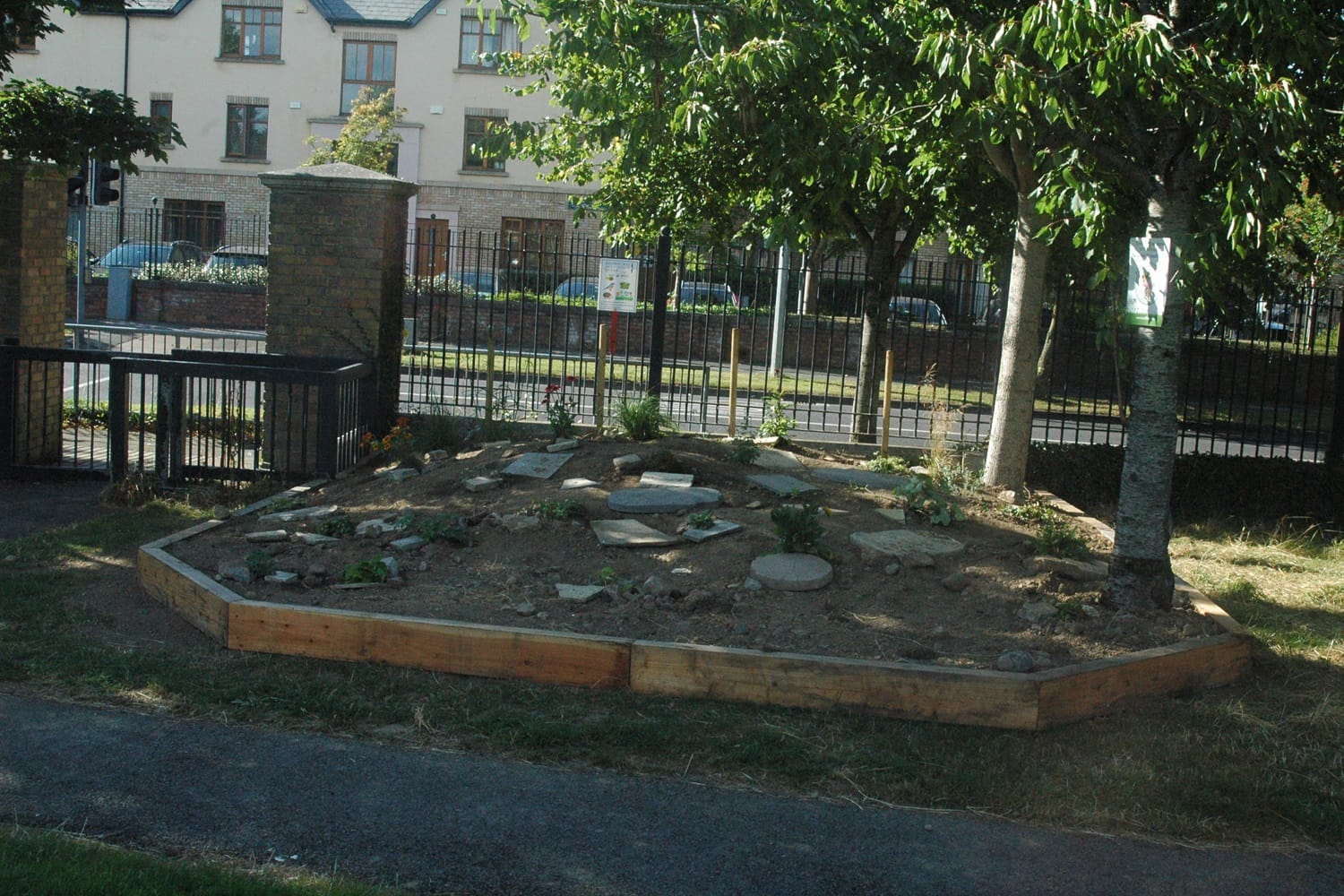What’s the best way to tell area residents about plans for a new asylum shelter nearby?
The government should tell communities directly about plans for new asylum shelters, some activists and politicians say.
The Riverwood Biodiversity Group has shaped the patch to tempt solitary bees, hedgehogs, and others. They hope neighbours will take inspiration from it.

Across the neighbourhood park on Riverwood Road in Porterstown last Tuesday, teams of kids chased basketballs, and thwacked back and forth in games of doubles tennis.
Frank Lynch, in a high-vis jacket, stopped by a sloping bed of soil near to the steel fences separating the green from the quiet suburban street.
The bed was in a wooden frame, about 5m long and wide. Bright and orangey-yellow rudbeckia flowers, purple verbena, salvia and bugloss grew up from the soil.
“It’ll attract the bees,” says Lynch, a local resident and member of the Riverwood Biodiversity Group.
Flat stones and broken tiles were scattered across the soil surface. Cracked, jagged, square, and swirled.
It keeps getting mistaken for a rock garden, says Lynch. But, “it’s a place for insects, hedgehogs to nestle and hide”.
The patch – a wildlife gardening exhibition – is the latest project from the biodiversity group, which was set up almost a year ago to protect and enhance the Dublin 15 suburb’s nature.
The idea is to show locals how they can help native wildlife within their own gardens, no matter how modest, says Mairead Stack, an ecologist and group member. “Even in a small space, you can do a certain amount.”
Stack and the group started to build the exhibition in early July.
They picked the spot because of the high footfall and because of the south-facing sloped soil, says Stack.
Stack hops up onto the raised bed. They’ve started a hedgehog hibernaculum at the top, she says. A couple of holes filled with broken twigs and branches.
“If you create a hollow space, and put logs up on top, then hedgehogs will come and hibernate under them,” says Stack.
The tip of a bamboo cane sticks out from the soil. “That is for solitary bees,” she says.
There are 77 species of solitary bee in Ireland, and they don’t form colonies or make honey, Stack says. “They make their burrows either in hollow canes or hollow spaces.”
Says Lynch: “We’re providing a home for them now, because they’re not as prevalent in the area.”
Although the cane isn’t supposed to be poking out, he says, as he climbs up to inspect and fix it.

The flat stones meanwhile provide shelter for insects, says Geraldine Danaher, a special-needs assistant in a local primary school. “It’s fantastic for things like earwigs and worms.”
It’s vital that insects are supported to make their homes, she says. “And we also have plans to make a pond for newts, frogs, and lizards.”
Smooth newts, one of only three amphibians native to Ireland, were recorded in Dublin during a survey carried out by the Irish Wildlife Trust in 2013.
Viviparous lizards, also known as common lizards, have been spotted around, Stack says. “We saw them on the Diswellstown Road last year, and they’re more common than people realise, but not as common as their name.”
The plan is to make a bog garden now, and a pond later, Stack says. “It’s a sunken sink, and it’ll be thickly planted with wet-loving plants, because most insects start in the larval state in water and then emerge.”
They want to add more sensory plants too, she says. “Like thyme, rosemary, garlic, coriander, all of those are wonderful for attracting pollinators.”
But next up, they will be planting fruit bushes, she says. “It’s all about not large items, because nobody in Riverwood has a big garden.”
The Riverwood Biodiversity Group was set up in September 2023, Stack says. “We’ve tried to hit the ground running with a few projects.”
Its first project was a pollinator patch of wildflowers on Riverwood Glebe, a street about 100 metres around the corner from the park.
In the park, they have started a mini woodland. Twenty-three young trees – oak, alder, ash, hawthorne – are growing in an area with long grass.
It’s about making small wildlife pockets in the neighbourhood and so building a network, Stack says. “We’re creating a little wildlife corridor.”
They are also charting the different pollinator areas in their own gardens using the National Biodiversity Data Centre’s “Actions for Pollinators”, an online mapping system.
“A year ago, there was nothing, and now you can see Riverwood has its own wildlife corridor going,” says Stack.
If they can get more people involved, that corridor could link up lots of neighbouring gardens, she says. “It could be leaving a little bit of grass in your garden, or growing a corner of nettles.”
The approach is science- and evidence-based, she says. “It is seeing what is possible in a housing estate.”
“What species do we want to focus on?” says Stack. “And what is it that they require and can we do that? So we pick the ones that we can do that for.”
Get our latest headlines in one of them, and recommendations for things to do in Dublin in the other.